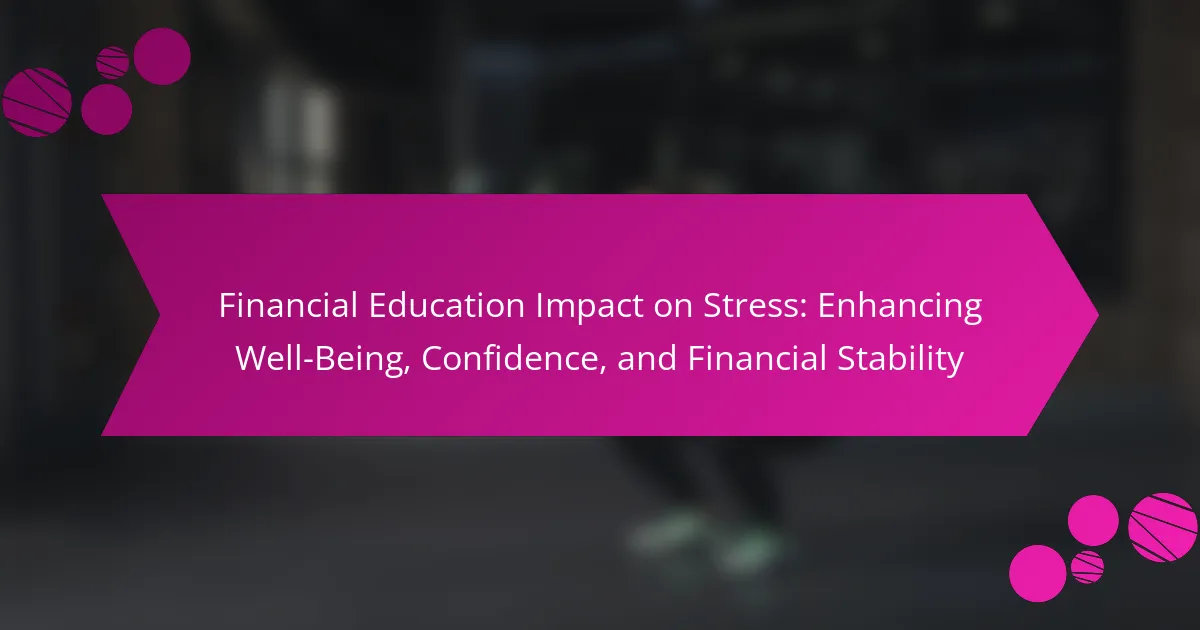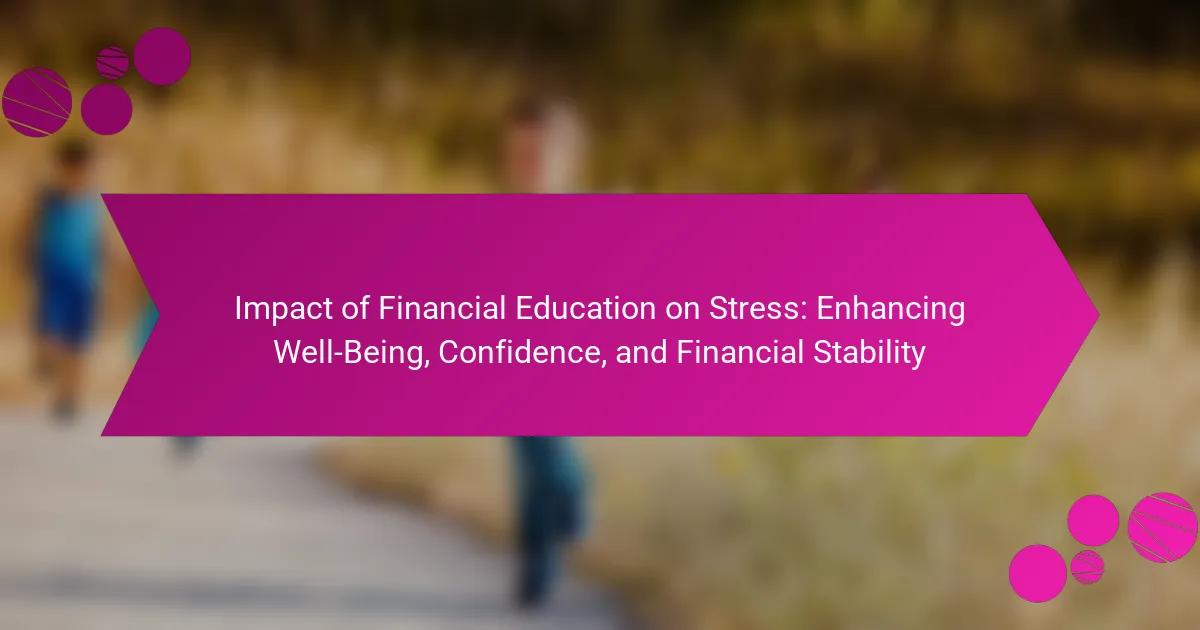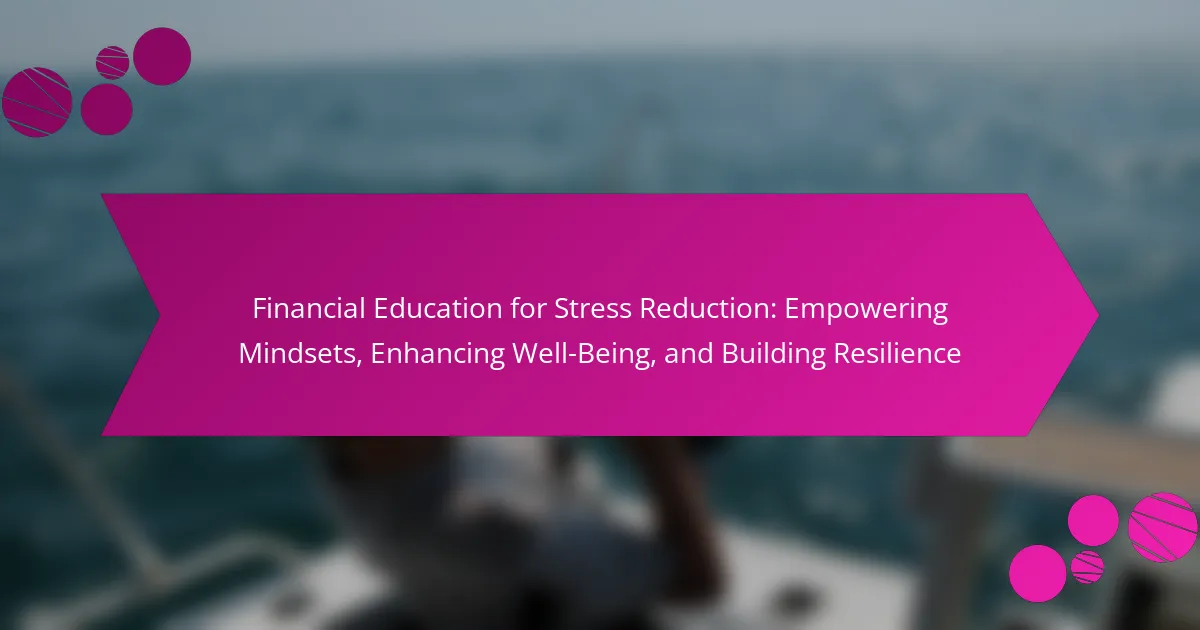Financial education significantly reduces stress and enhances well-being by equipping individuals with essential skills for effective money management. It fosters financial confidence, leading to improved resilience and higher life satisfaction. This article explores the benefits of financial education, effective strategies for teaching it, and the importance of tailoring content to specific demographics. By focusing on budgeting, goal setting, and real-life applications, individuals can build a more secure financial future.

How does financial education influence stress levels?
Financial education significantly reduces stress levels by providing individuals with the knowledge and skills to manage their finances effectively. This understanding enhances financial confidence, leading to lower anxiety related to money management. Studies show that individuals with financial education report higher resilience and improved well-being, as they feel more equipped to handle financial challenges. By developing budgeting skills and understanding investment options, people can create more stable financial futures, further alleviating stress.
What are the psychological effects of financial literacy?
Financial literacy significantly improves psychological well-being by reducing stress and enhancing confidence. Individuals with strong financial education exhibit lower anxiety levels related to money management. This knowledge empowers them to make informed decisions, fostering resilience against economic challenges. Studies show that financial literacy correlates with increased life satisfaction, as individuals feel more in control of their financial futures. Furthermore, enhanced financial confidence leads to better coping strategies during financial crises, contributing to overall mental health.
How does knowledge of budgeting reduce anxiety?
Knowledge of budgeting significantly reduces anxiety by providing clarity and control over financial situations. When individuals understand their income and expenses, they can make informed decisions, leading to increased confidence. This financial education empowers individuals to anticipate challenges, create realistic plans, and set achievable goals. As a result, they experience less stress related to unexpected expenses or financial emergencies. Comprehensive budgeting skills can transform financial anxiety into proactive management, enhancing overall well-being.
What budgeting techniques can alleviate financial stress?
Effective budgeting techniques can significantly reduce financial stress. Strategies such as the 50/30/20 rule, zero-based budgeting, and the envelope system help individuals manage their finances more effectively.
The 50/30/20 rule allocates 50% of income to needs, 30% to wants, and 20% to savings and debt repayment. This method simplifies decision-making and promotes financial balance.
Zero-based budgeting requires every dollar of income to be assigned a specific purpose, ensuring that expenses do not exceed income. This approach fosters accountability and awareness of spending habits.
The envelope system involves dividing cash into envelopes for different spending categories. This tangible method helps control overspending and encourages mindful spending.
Implementing these techniques can enhance financial confidence and promote overall well-being.
How can tracking expenses improve financial confidence?
Tracking expenses significantly boosts financial confidence by providing clarity and control over personal finances. When individuals monitor their spending, they can identify patterns, prioritize needs, and adjust habits accordingly. This awareness leads to informed decision-making, reducing the anxiety associated with financial uncertainty.
Additionally, tracking expenses helps establish realistic budgets, enabling individuals to set achievable financial goals. As a result, they feel empowered to save and invest wisely, fostering a sense of financial resilience. Regularly reviewing expenses can also highlight areas for improvement, reinforcing positive financial behaviors and enhancing overall well-being.

What unique benefits does financial education provide for well-being?
Financial education uniquely enhances well-being by reducing stress and building financial confidence. Individuals equipped with financial knowledge experience lower anxiety related to money management. This education fosters resilience, enabling better decision-making in financial matters, which leads to increased overall satisfaction. Studies show that financially educated individuals report higher levels of happiness and security, positively impacting their mental health.
How does financial literacy correlate with overall life satisfaction?
Financial literacy significantly enhances overall life satisfaction by reducing stress and building financial confidence. Individuals with strong financial education tend to experience lower anxiety related to money management. Research indicates that financial literacy correlates with improved decision-making, leading to better financial outcomes. As a result, this empowerment fosters a sense of control and well-being, contributing positively to life satisfaction.
What role does financial planning play in enhancing mental health?
Financial planning significantly enhances mental health by reducing financial stress and fostering a sense of control. Effective financial education equips individuals with skills to manage their resources, leading to improved resilience and well-being. Studies show that individuals with clear financial plans report lower anxiety levels and greater life satisfaction. Additionally, financial confidence promotes proactive decision-making, further alleviating stress.
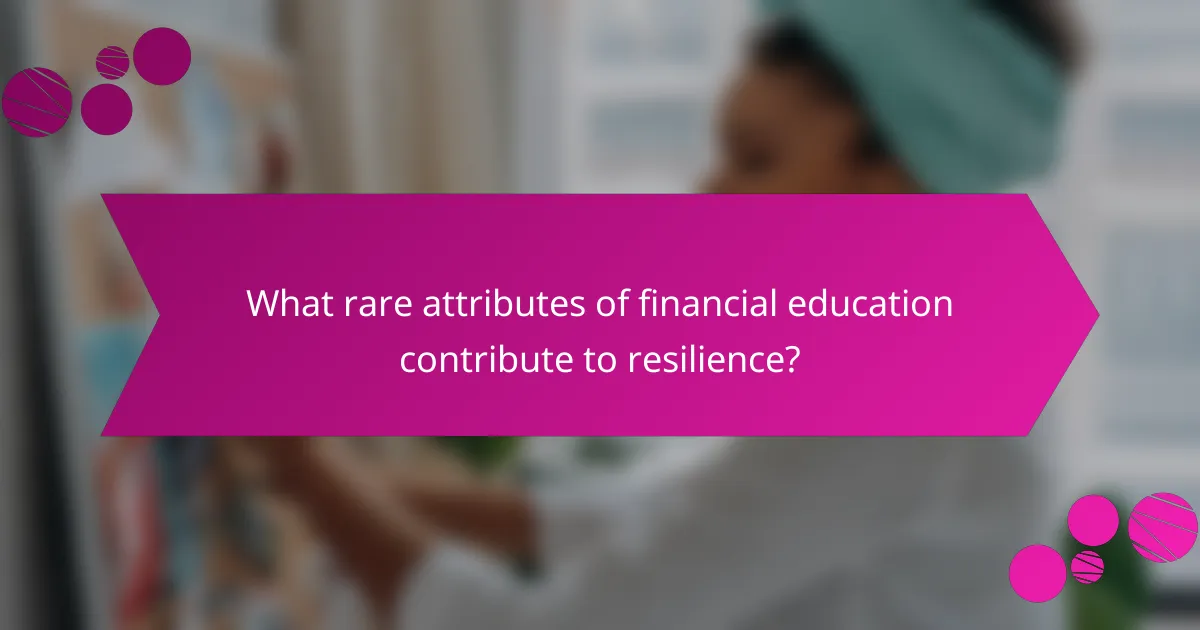
What rare attributes of financial education contribute to resilience?
Financial education enhances resilience through unique attributes such as adaptability, critical thinking, and emotional regulation. These attributes empower individuals to navigate financial challenges effectively. For example, adaptability enables quick responses to economic shifts, while critical thinking fosters informed decision-making. Emotional regulation supports stress management, promoting overall well-being. Together, these rare attributes cultivate financial confidence, reducing anxiety and enhancing life satisfaction.
How can financial education foster a sense of community?
Financial education fosters a sense of community by promoting collaboration and shared learning experiences. It encourages individuals to discuss financial challenges and solutions, creating bonds through mutual support. This collective engagement enhances financial confidence, reduces stress, and improves overall well-being. Communities that prioritize financial education often see increased resilience, as members exchange valuable resources and strategies. As a result, financial literacy becomes a shared goal, strengthening connections and fostering a supportive environment.
What impact does financial education have on decision-making skills?
Financial education significantly enhances decision-making skills by fostering financial confidence and reducing stress. Individuals equipped with financial knowledge are better prepared to evaluate options, anticipate outcomes, and make informed choices. Research indicates that financial literacy correlates with improved budgeting, saving, and investment decisions, ultimately leading to greater financial resilience. As a result, individuals experience enhanced well-being and reduced anxiety related to financial matters.
How can improved decision-making reduce stress?
Improved decision-making reduces stress by enhancing financial education, which builds resilience and confidence. When individuals understand financial concepts, they can make informed choices, leading to better outcomes and less anxiety. Research shows that financial literacy directly correlates with lower stress levels, as individuals feel more in control of their finances. This empowerment not only alleviates immediate stress but also fosters long-term well-being and stability.
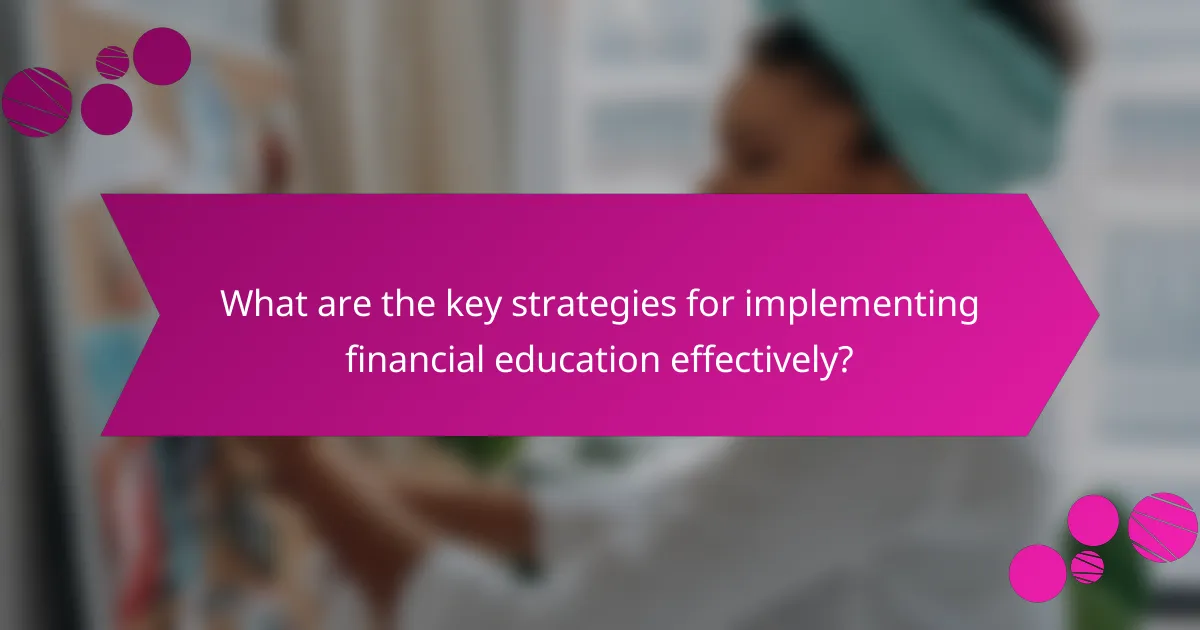
What are the key strategies for implementing financial education effectively?
Effective financial education strategies include integrating real-life applications, fostering a supportive environment, and utilizing diverse teaching methods. Real-life applications enhance relevance, while a supportive environment encourages open discussions about financial challenges. Diverse teaching methods cater to different learning styles, promoting better retention of information. Regular assessments can also track progress and adjust strategies as needed.
What resources are available for enhancing financial literacy?
Various resources enhance financial literacy, including online courses, workshops, and financial counseling. Many organizations offer free educational materials, such as budgeting tools and investment guides. Local libraries often provide access to financial literacy programs. Additionally, mobile apps can help track expenses and savings goals. Nonprofits and community centers frequently host seminars on financial topics, promoting resilience and confidence.
How can individuals create a personalized financial education plan?
Individuals can create a personalized financial education plan by assessing their current financial situation, identifying specific goals, and selecting tailored resources. Start by evaluating income, expenses, and debts to establish a baseline. Next, set clear objectives, such as saving for retirement or reducing debt. Then, choose educational materials like books, online courses, or workshops that align with your goals. Regularly review and adjust your plan to ensure it remains relevant and effective. This approach builds financial confidence and resilience, ultimately enhancing well-being.
What steps should be taken to set financial goals?
To set financial goals, start by assessing your current financial situation. Define specific, measurable, achievable, relevant, and time-bound (SMART) goals. Prioritize your goals based on urgency and importance. Create a detailed plan outlining steps and resources needed to achieve each goal. Regularly review and adjust your goals as circumstances change.
What common mistakes should be avoided in financial education?
Avoiding common mistakes in financial education is crucial for building confidence. Key mistakes include neglecting budgeting, failing to understand credit, ignoring savings, and underestimating investment risks. These errors can lead to financial stress and hinder resilience. For instance, a lack of budgeting often results in overspending, while misunderstanding credit can damage credit scores. Establishing a solid financial foundation requires awareness and proactive management of these elements.

How can financial education be tailored to specific demographics?
Financial education can be tailored to specific demographics by addressing their unique financial needs and challenges. For instance, younger audiences may benefit from digital tools and gamified learning, while older adults might require in-person workshops focusing on retirement planning.
Cultural context is crucial; financial literacy materials should reflect the values and experiences of diverse communities. This approach enhances engagement and retention, making the education more relevant.
Targeting specific demographics can also involve using relatable scenarios and examples. For example, low-income families may need lessons on budgeting and saving, while entrepreneurs might focus on cash flow management and investment strategies.
Ultimately, a personalized approach fosters financial resilience, reduces stress, and enhances overall well-being by building confidence in financial decision-making.
What considerations are important for teaching financial literacy to young adults?
Teaching financial literacy to young adults requires a focus on practical skills, emotional resilience, and real-life applications. Key considerations include tailoring content to their experiences, emphasizing the importance of budgeting, saving, and understanding credit. Engaging them through interactive methods enhances retention and confidence. Incorporating technology, such as budgeting apps, can also facilitate learning. Additionally, fostering a supportive environment encourages open discussions about financial challenges and successes, building a foundation for lifelong financial well-being.
How can financial education address the needs of low-income families?
Financial education can significantly empower low-income families by enhancing their financial confidence and resilience. It equips them with essential skills to manage budgets, understand credit, and make informed financial decisions. Studies show that financial education can reduce stress levels, leading to improved overall well-being. Furthermore, families with financial literacy are better positioned to build savings and navigate economic challenges, ultimately fostering long-term financial stability.

What actionable tips can improve financial confidence and well-being?
To improve financial confidence and well-being, focus on education, budgeting, and goal setting. Develop a comprehensive understanding of personal finance, including investment basics and debt management. Create a realistic budget that tracks income and expenses, ensuring you live within your means. Set achievable financial goals, both short-term and long-term, to provide motivation and a clear path forward. Regularly review and adjust your financial plans to adapt to changing circumstances.
How can regular financial check-ins enhance resilience?
Regular financial check-ins significantly enhance resilience by fostering proactive financial management. They allow individuals to monitor their financial health, identify potential issues early, and adjust strategies accordingly. This practice reduces stress and builds confidence, as individuals feel more in control of their financial situations. Furthermore, consistent check-ins can lead to better budgeting habits and informed decision-making, ultimately enhancing overall well-being.
What best practices should individuals adopt for ongoing financial education?
To enhance ongoing financial education, individuals should adopt practical strategies that promote continuous learning and application. Engaging in regular financial workshops helps build knowledge and confidence. Utilizing mobile apps for budgeting and tracking expenses fosters real-time financial awareness. Joining community groups or online forums encourages sharing experiences and tips, enhancing understanding. Setting specific financial goals provides direction and motivation for continuous education. Lastly, reading financial literature and following reputable financial news sources keeps individuals informed on market trends and best practices.
How can community resources support financial literacy initiatives?
Community resources enhance financial literacy initiatives by providing access to educational programs, workshops, and support networks. These resources foster collaboration between organizations, creating a comprehensive framework for financial education. For example, local nonprofits often offer free classes on budgeting and saving, which directly contribute to building financial confidence. Additionally, community centers may host events that connect individuals with financial advisors, further reducing stress related to financial management. By leveraging these resources, communities can create a culture of financial resilience, improving overall well-being.
